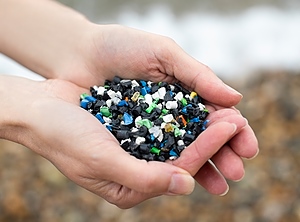RESEARCH
Development of two sugar-based polymers / Qualities said to be like common plastics / Custom mechanical properties, degradation rates reportedly possible
 Sugar-based polymers display similar properties to commercial plastics (Photo: University of Birmingham) |
Researchers at the UK’s University of Birmingham (www.birmingham.ac.uk) and US-based Duke University (www.duke.edu) have created two sugar-based polymers said to have properties similar to those of common plastics, and the materials are degradable and mechanically recyclable. One is stretchable like rubber, the other tough but ductile, much like most commercial plastics, according to the inventors.
The polymers are based on isoidide and isomannide, compounds made from sugar alcohols that feature a rigid ring of atoms. The researchers found that the isoidide-based polymer showed a stiffness and malleability similar to common plastics, and a strength much like high-grade engineering plastics such as polyamide 6. “Despite isoidide and isomannide only differing by the 3D spatial orientation of two bonds, known as stereochemistry, the isomannide-based material had similar strength and toughness but also showed high elasticity, recovering its shape after deformation. Notably, the materials retained their excellent mechanical properties following pulverisation and thermal processing, which is the usual method for mechanically recycling plastics.”
For possible applications, a university representative told Plasteurope.com, “These types of polymers are likely to be used in industries such as construction, automotive, electrical, healthcare, coatings, robotics, and electronics. They may be, for instance used for smartphone casings, or interior panels in cars.”
Related: Scientists turn biomass-produced plastics back into fertiliser
By creating copolymers that contain both isoidide and isomannide units, researchers found that they could control the mechanical properties and degradation rates independently of one another. Hence, unique shapes of sugars can be used to tune the degradability for a specific use without significantly altering the properties of the material.
Josh Worch from Birmingham’s School of Chemistry, a co-author of the research said, “The ability to blend these polymers together to create useful materials offers a distinct advantage in recycling, which often has to deal with mixed feeds.”
The researchers are now looking for industrial partners interested in licensing the technology. A joint patent application for the polymers has been filed by the universities.
The polymers are based on isoidide and isomannide, compounds made from sugar alcohols that feature a rigid ring of atoms. The researchers found that the isoidide-based polymer showed a stiffness and malleability similar to common plastics, and a strength much like high-grade engineering plastics such as polyamide 6. “Despite isoidide and isomannide only differing by the 3D spatial orientation of two bonds, known as stereochemistry, the isomannide-based material had similar strength and toughness but also showed high elasticity, recovering its shape after deformation. Notably, the materials retained their excellent mechanical properties following pulverisation and thermal processing, which is the usual method for mechanically recycling plastics.”
For possible applications, a university representative told Plasteurope.com, “These types of polymers are likely to be used in industries such as construction, automotive, electrical, healthcare, coatings, robotics, and electronics. They may be, for instance used for smartphone casings, or interior panels in cars.”
Related: Scientists turn biomass-produced plastics back into fertiliser
By creating copolymers that contain both isoidide and isomannide units, researchers found that they could control the mechanical properties and degradation rates independently of one another. Hence, unique shapes of sugars can be used to tune the degradability for a specific use without significantly altering the properties of the material.
Josh Worch from Birmingham’s School of Chemistry, a co-author of the research said, “The ability to blend these polymers together to create useful materials offers a distinct advantage in recycling, which often has to deal with mixed feeds.”
The researchers are now looking for industrial partners interested in licensing the technology. A joint patent application for the polymers has been filed by the universities.
09.02.2022 Plasteurope.com [249498-0]
Published on 09.02.2022
